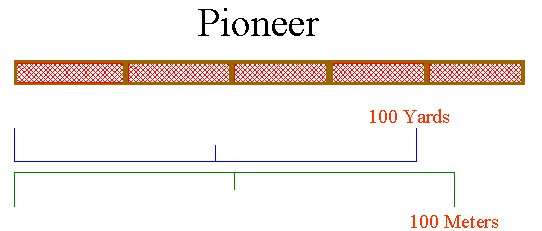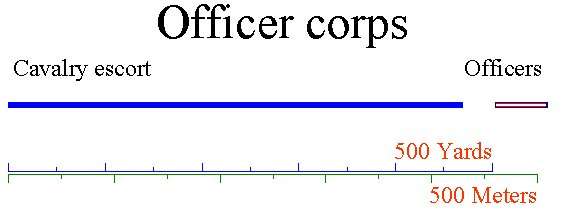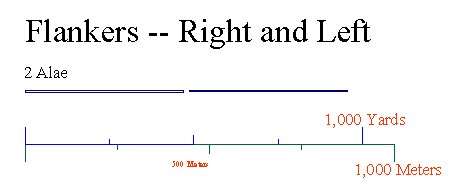The order of march
The order in which the various units moved is uncertain. Delbrück, who devoted over 600 pages of his 4-volume work on the History of Warfare to Rome only wrote a single sentence about the march saying that he didn't have enough information to speculate. More recent authors do give some opinions about the order of march. The order used here follows Connolly in large part but is supplemented by information from Peddie. This model should not be taken too seriously, its only purpose is to account for all of the elements of the 4 legion army in a reasonable sequence.
The march formation described by Connolly is divided into the following general units, each of which will be described below. The units are: The scouts, the vanguard, the surveyors, the Pioneer corps, the officers; baggage, the commanding general and his attendants, the legion pack train consisting of the artillery, food, legion baggage for the vanguard and rear guard legions, and supplemental supplies, the officer corps, the legions each with their own baggage, the rear guard and the flank guards. Peddie is not as detailed but from his account of the departure and arrival times it is clear that the baggage follows the legions instead of preceding them as in Connolly's model. Peddie does not argue the point but does suggest that the fortification process for the new camp would not begin until the arrival of the second legion. The first legion on the scene would be deployed in a defensive position. The serious work of fortification could not begin in earnest until the second legion had arrived. Were the baggage to be sent ahead of the legions it would slow down the entire march and delay the start of fortifications. And, since the process of trenching would take at least several hours, it would be important that it begin as early in the day as possible. I believe this argues strongly for the legions to precede the baggage.
Consequently I have changed the order of march as Connolly presented it to bring the general and officer staff after the vanguard legion, followed by the main body of legions, then the baggage all together with substantial cavalry guard, followed by one legion and cavalry as a strong rear guard.
Scouts
A scouting unit of cavalry and skirmishers was stationed 800 yards in front of the main body. Peddie gives no figures for its numbers. I have assigned 1/2 of the skirmishers and 1/8 of the auxiliary cavalry to scouting. That is, four centuries of archers, four of slingers and one ala of auxiliary cavalry. The pack animals for these units are positioned with the overall army supply train.
Vanguard
The vanguard consisted of one legion and cavalry. The legion was chosen by lot daily. In the illustration below there is one auxiliary and one Roman ala in front of the vanguard. The vanguard would have been some distance in front of the army, Peddie gives 800 yards as a likely distance.
Survey
Connolly describes the survey group as comprised of one man from each contubernium, 1/4 of them are detailed in the column to the right. The four red rectangles indicate the size of the entire unit. The three to the right are shorter because they do no have the officer, vexillarius and cornicines leading them. Because the unit would be laying out the camp and its fortifications I have added 10 fabri with mules for their tools and surveying instruments. The fabri and their mule train are illustrated in the column on the left.
This illustration shows the entire survey unit in its order of march. 
Pioneer
Connolly does not describe the composition of the pioneer corps. I have arbitrarily chosen to assign one cohort and ten engineers to the corps. The illustration below shown them in their order of march.
General
The illustration below shows the bodyguard cohort (blue) and the general with his entourage(red). Officer corps
Officer corps
Chief among the officers is the quaestor. Then there are the officers of the four legions: the legati in charge of each legion and the six tribunes assigned to each legion. Each legatus is accompanied by one of each of the types of aeneatores. Also included is the commander of the allied cavalry and the quaestor. The quaestor is accompanied by four clerks. The officers are grouped by legion.
The legions
The three legions take just a little over two miles in the column.
Baggage train
The following illustration shows the entire baggage train in the order of march. First come the evocati as a guard unit. Then the baggage of the commanding general and the officers. This is followed by the baggage of the legionaries, then that of the staff for the legions, the Roman alae and the archers and slingers. In roughly the middle of the train there is another mounted guard of two Roman alae. They are followed by the baggage for the army; its artillery, supplies and food. And finally there is the baggage of the evocati, bodyguards and auxiliary cavalry.
In the model above the baggage train has been grouped by similar types. That is, all of the artillery, food and supplies for each of the four legions has been grouped together. In favor of this model is that within the camp it these units would have tented in a common area and the march would proceed more orderly if they also marched together.
The Romans also organised their order of march legion by legion, with the baggage of each legion accompanying the legionaries. I have not shown the entire column with this organisation but do show, below, one legion and its baggage. Were a legion to march on its own, as they often did, this would approximate the formation, although the legion would probably have advance and rearguards that are not shown.
Rearguard
Connolly describes the rearguard as light and heavy infantry plus a considerable number of auxiliary cavalry. Peddie simply puts 1,000 cavalry there. I have compromised and designated half the skirmishers and two auxiliary alae to the rear guard, but no heavy infantry. The alae are at the end since they are the more mobile and could more easily fight a rear guard action and then catch up to the main body.
Flank guards
Some cavalry units would have been used as flankers to protect against surprise attacks. Peddie places 1,000 cavalry on each flank, however he is working with a larger force. This model shows two alae on each flank, 660 men.
The entire column
The illustration below puts all of the elements together to show the entire column of march for a 4-legion army as I have described it. This column extends almost 15 miles. Connolly and Peddie, both describing larger armies, describe columns over 20 miles long. The column would be considerably extended if the roads being used did not allow the army to march 6 abreast.
In this illustration the scouts are positioned 800 yards in front of the vanguard. The flanking units are not shown.
It is significant to note the extent of the baggage train, nearly eight miles from front to back. This vulnerable part of the column would have been difficult to defend. If there were an attack on the middle of the baggage train it would be approximately four miles to the rearguard and to nearest legion front, but nearly six miles to the foremost legion. Signaling horns could raise the alarm from one end of the column to the other almost instantaneously. The mounted rearguard could cover the distance in about 10 or 15 minutes but would take between one and two hours for the legions to arrive on the scene.

1 comment
Great study.